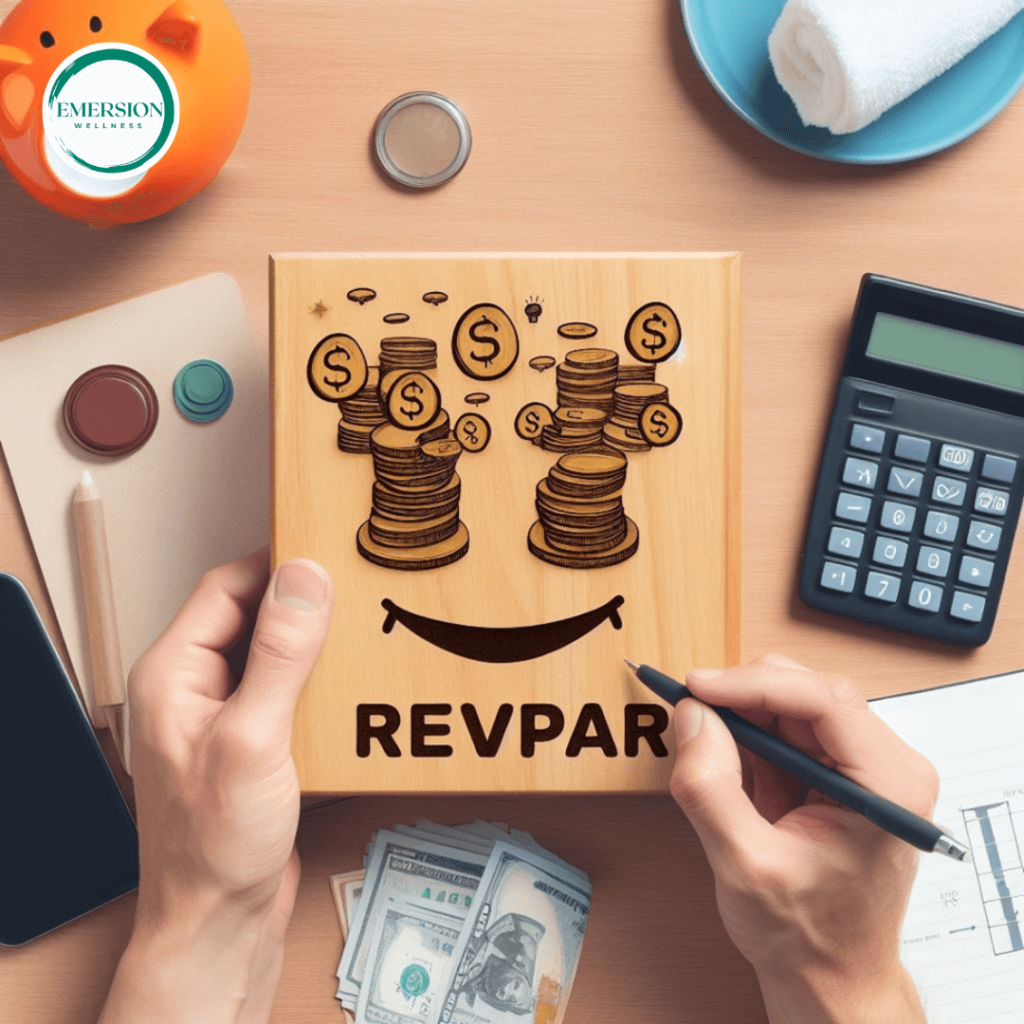Revenue per available room is one of the most valuable metrics for benchmarking financial performance and making strategic decisions to boost the bottom line. Knowing what it means, how to calculate RevPAR, and how to apply RevPAR analysis allows hoteliers to thrive.
This definitive guide will explain the meaning of Revenue per available room, how to calculate it, and most importantly - how to actually use your RevPAR statistics to implement revenue-generating strategies that fill rooms and optimise profits.
Key Takeaways
- Learn the exact definition of RevPAR (Revenue per available room) and what it measures
- Master the formula for accurately calculating a hotel's Revenue per available room.
- Study sample RevPAR calculations for total Revenue and by market segment
- Discover five key ways to leverage Revenue per available room data to drive hotel revenues
- Utilise Revenue per available room trends to forecast demand, optimise pricing, and set Growth-driven KPIs
Understanding and applying Revenue per available room metrics is crucial for maximising occupancy, average daily rate (ADR), and, ultimately, revenues. Let's dive in.
Table of Contents
What is RevPAR? The Meaning and Value of this Key Metric
RevPAR stands for Revenue per available room. This critical hotel industry metric measures the total guest room revenue generated divided by the total number of available rooms in a given period.
In simple terms, RevPAR shows the average income earned per available room. It combines two key performance indicators - occupancy percentage and average daily rate (ADR).
Tracking RevPAR reveals how well your hotel is generating Revenue based on demand trends and pricing strategies. It benchmarks your financial productivity against total room capacity.
High Revenue per available room indicates rooms are selling at optimal rates. Low RevPAR shows opportunities to boost occupancy, ADR, or both.
Monitoring RevPAR over time identifies seasonal patterns and demand fluctuations. Comparing Revenue per available room to previous years and competitive sets spotlights revenue growth opportunities.
In short, understanding Revenue per available room allows hoteliers to establish data-driven pricing, measure marketing success, optimise channel mix, and maximise revenues overall.
Now that we've covered the meaning and value of Revenue per available room, let's look at how actually to calculate this critical metric for your hotel.
How do you calculate Revenue per available room step-by-step?
Here is the step-by-step process for accurately calculating your hotel's total Revenue per available room:
Step 1) Determine the period you want to analyse (ex: last month, last year, etc.)
Step 2) Add up all the room revenue from occupied paid rooms during that period. This is your total room revenue (TRR).
Step 3) Calculate the total number of available rooms during that same period.
Step 4) Divide the total room revenue by the number of available rooms to get RevPAR.
RevPAR Formula:
RevPAR = Total Room Revenue / Total Available Rooms
Let's look at some examples to see Revenue per available room calculations in action.
RevPAR Calculation Examples and Formulas
Below are sample Revenue per available room calculations using accurate hotel metrics:
Total Hotel Revenue per available room
Let's say last month your hotel had:
- Total room revenue (TRR) = $94,500
- Total available rooms = 3,650
RevPAR = Total Monthly Room Revenue / Total Monthly Available Rooms
Revenue per available room = $94,500 / 3,650 rooms
Your total Revenue per available room = $25.90
This means your hotel earned an average of $25.90 in revenue for each available room last month.

Revenue per available room by Market Segment
You can also calculate Revenue per available room for specific market segments.
For example, last month your:
- Leisure segment TRR = $22,100
- Leisure segment available rooms = 1,500
Leisure Revenue per available room = $22,100 / 1,500 = $14.73
Meanwhile, your:
- Group segment TRR = $52,400
- Group available rooms = 1,800
Group Revenue per available room = $52,400 / 1,800 = $29.11
Segment Revenue per available room reveals which markets drive higher revenues so you can focus sales and marketing efforts appropriately.
Now that you understand how to calculate Revenue per available room, let's explore ways to turn RevPAR data into actionable revenue generation strategies.
5 Ways to Strategically Use Revenue per Available Room Data to Boost Hotel Revenues
Carefully analysing your Revenue per available room statistics and trends allows you to make intelligent revenue management decisions. Here are five ways to convert RevPAR insights into increased revenues:
1. Set Revenue per available room growth Targets
Set specific Revenue per available room growth goals for the year ahead by market segment, month, or interval. This provides KPIs to drive focused revenue growth strategies.
2. Forecast Demand Trends
Study historical Revenue per available room patterns by month, day of week, and market segment. Identify high vs low demand periods to optimise pricing and promotional offers.
3. Benchmark Competitor Performance
Compare your Revenue per available room against local and regional competitors to find opportunities to capture market share. This enables strategic positioning.
4. Optimise Room Rates
Analyse Revenue per available room by price point to determine ideal rate tiers for each room type, view, and season. This allows precision pricing to maximise RevPAR.
5. Monitor Campaign Performance
Compare Revenue per available room during and after marketing campaigns or over critical demand periods. This reveals campaign ROI and supports future budget decisions.
By actively applying Revenue per available room insights, hoteliers can implement revenue management strategies that attract guests, fill rooms at premium rates, and hit revenue goals.
Revenue per available room is clearly one of the most valuable metrics for hotel revenue management. By truly understanding what Revenue per available room means, diligently calculating it for your property, and proactively applying the data to drive strategic decisions, hoteliers can maximise occupancy, ADR, and bottom-line profits. Harness the power of RevPAR analysis to keep your hotel thriving for years to come.
For expert guidance in optimising your Revenue per available room or implementing other revenue-boosting strategies, the team at Emersion Wellness has the experience and tools to help your hotel succeed.
Contact us today to start driving results!
Revenue per available room FAQs
Still have questions about calculating and leveraging Revenue per available room? Here are answers to frequent queries:
How is Revenue per available room different from occupancy percentage?
Occupancy percentage measures the number of rooms sold, while Revenue per available room shows the average Revenue earned per available room. High occupancy doesn't guarantee strong RevPAR.
What's a good Revenue per available room for a hotel?
Ideal RevPAR varies significantly by location, hotel segment, and season. A lower RevPAR may be suitable for an economy hotel, while higher-end hotels target over $200 in Revenue per available room. Set goals based on historical trends and local competitors.
Can Revenue per available room be more than 100%?
Yes, RevPAR percentages over 100% are possible if a hotel achieves high occupancy along with rates exceeding their average. This happens during peak seasons or events.
Should Revenue per available room be based on the number of available rooms sold or the total number of rooms?
RevPAR calculations are based only on rooms available for sale. Rooms marked out of order should not be included in the available room count to enable an accurate RevPAR measurement.
How often should hotel Revenue per available room be calculated?
Leading hotels calculate RevPAR daily. At a minimum, evaluate monthly RevPAR to identify trends and quickly respond to changes in demand or market conditions.
Carefully tracking and analysing RevPAR statistics provides hotel managers with data-driven insights to strategically maximise revenues. For hands-on guidance in optimising your hotel's RevPAR and implementing revenue management best practices, contact our team at Emersion Wellness. Our revenue generation strategies deliver results.
Contact us for more details.

I'm Nathan Baws, a nutrition nerd, exercise and weight loss expert, and an unwavering advocate for good health. As the founder of Emersion Wellness, I'm passionate about crafting Seamless Weight Loss Programs to supercharge hotel revenue and transform lives. We've pioneered the World's First Plug & Play Weight Loss Programs for top hotels and resorts, sparking a wellness revolution. Beyond my professional journey, you'll often find me hiking, swimming, and riding the waves, embracing every moment in nature. Join me on this exhilarating journey towards diet, health and wellness.

